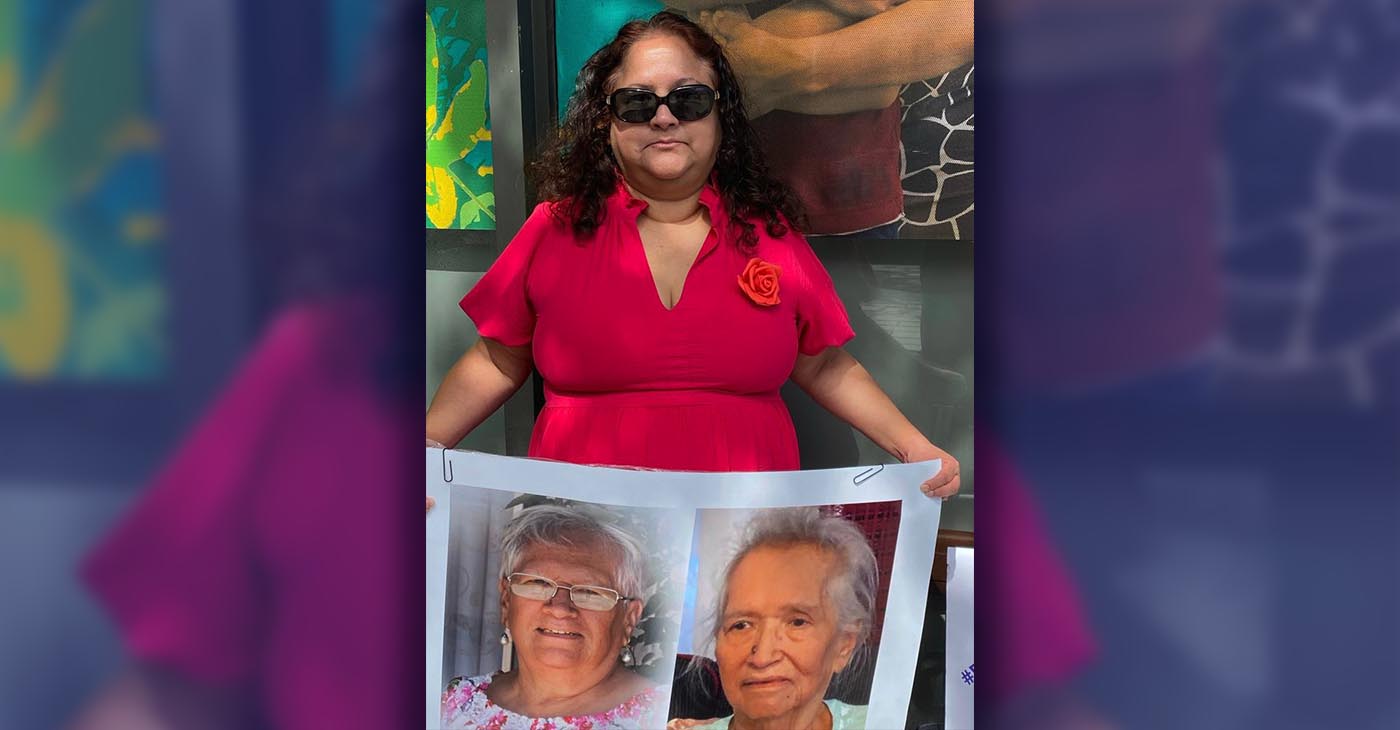Activism
Protesters Demand Further Investigation After Alameda County Grand Jury Report Ignores Flagrant Probate Abuses
Cathy Rodriguez was denied the conservatorship of her aunt, 88-year-old Mildred Rodriguez, despite sharing ownership of the mobile home they lived in. Mildred’s estate was handed over to a public guardian because of a dispute between Cathy and a cousin, Rose Rivera, who had placed the mobile home and Mildred’s retirement and assets in her name.

By Tanya Dennis
The release last month of Alameda County’s Grand Jury report charging deficiencies in the Alameda County Probate Court system has set off a firestorm of activity by probate reform groups that say the report did not go far enough.
Affected family members and activists gathered outside of the Alameda County Supervisors Administration office Aug. 11 to protest the failure of the Grand Jury to address the families’ losses of their loved ones and their estates.
According to the protesters, the Grand Jury report failed to address the ongoing enrichment of court-appointed guardians or conservators to the detriment of conservatees and their families.
“Protesters want the presiding probate judge, Charles Smiley, the Grand Jury and the County Board of Supervisors to genuinely consider their complaints of guardianship abuse and reopen the Grand Jury investigation,” said Venus Gist of California Justice.
Samantha Dussell and Cecily Dussell were among those outside the courthouse. “I’m out here protesting today because my mother’s civil rights were violated,” said Samantha Dussell. She and her daughter, Cecily Dussell, had filed a verified petition to remove the public guardian from their mother/grandmother, Rosalie Hope Sifuentez.
“In every aspect of my mother’s life, there has been a lack of common sense and integrity and contempt for her that has been used in making decisions for her daily care, health care, emotional and spiritual needs and living environment,” Samantha said.
Also protesting was Doris Lilly who alleges that the estate of her aunt, 97-year-old Christine Williams, was taken and sold by the man who prepared Williams’ taxes.
Lilly said that Williams’ tax preparer utilized his access to Williams’ documents, changed her will, her power of attorney, placed his name on her accounts, then sold her $800,000 home for $605,000, gave $100,000 to two nephews and has not been held accountable by the court to report what happened to the $405,000 balance of her estate despite requests from the family.
Cathy Rodriguez was denied the conservatorship of her aunt, 88-year-old Mildred Rodriguez, despite sharing ownership of the mobile home they lived in. Mildred’s estate was handed over to a public guardian because of a dispute between Cathy and a cousin, Rose Rivera, who had placed the mobile home and Mildred’s retirement and assets in her name.
Rather than assist Cathy in returning the assets she shared with Mildred, the conservator reported to the court that Mildred did not trust Cathy, despite a hand-written note by Mildred that she did not like the care facility she was in and wished to live with Cathy.
Rivera, the Public Guardian, filed a complaint claiming Cathy’s behavior was disruptive and prohibited her from having any contact with her aunt.
“The system is abusing my auntie and keeping her in prison with no contact with the outside world,” Rodriguez says. In a video recording, Mildred states “I want out of here. I want out of this place. I don’t like staying here and being with these people, I want to live with Cathy.”
Activism
Oakland Post: Week of July 24 – 30, 2024
The printed Weekly Edition of the Oakland Post: Week of July 24 – 30, 2024

To enlarge your view of this issue, use the slider, magnifying glass icon or full page icon in the lower right corner of the browser window. ![]()
Activism
Oakland Post: Week of July 17 -23, 2024
The printed Weekly Edition of the Oakland Post: Week of July 17 -23, 2024

To enlarge your view of this issue, use the slider, magnifying glass icon or full page icon in the lower right corner of the browser window. ![]()
Activism
Community Celebrates Historic Oakland Billboard Agreements
We, the Oakland Billboard Economic Development Coalition, which includes Oakland’s six leading community health clinics, all ethnic chambers of commerce, and top community-based economic development organizations – celebrate the historic billboard agreements approved last year by the Oakland City Council. We have fought for this opportunity against the billboard monopoly, against Clear Channel, for five years. The agreements approved by Council set the bar for community benefits – nearly $70 Million over their lifetime, more than 23 times the total paid by all previous Clear Channel relocation agreements in Oakland combined.

Grand Jury Report Incorrect – Council & Community Benefit
We, the Oakland Billboard Economic Development Coalition, which includes Oakland’s six leading community health clinics, all ethnic chambers of commerce, and top community-based economic development organizations – celebrate the historic billboard agreements approved last year by the Oakland City Council. We have fought for this opportunity against the billboard monopoly, against Clear Channel, for five years. The agreements approved by Council set the bar for community benefits – nearly $70 Million over their lifetime, more than 23 times the total paid by all previous Clear Channel relocation agreements in Oakland combined.
Unfortunately, a recent flawed Grand Jury report got it wrong, so we feel compelled to correct the record:
- Regarding the claim that the decision was made hastily, the report itself belies that claim. The process was five years in the making, with two and a half years from the first City Council hearing to the final vote. Along the way, as the report describes, there were multiple Planning Commission hearings, public stakeholder outreach meetings, a Council Committee meeting, and then a vote by the full Council. Not only was this not hasty, it had far more scrutiny than any of the previous relocation agreements approved by the City with Clear Channel, all of which provide 1/23 of the benefits of the Becker/OFI agreements approved by the Council.
- More importantly, the agreements will actually bring millions to the City and community, nearly $70M to be exact, 23 times the previous Clear Channel relocation agreements combined. They certainly will not cost the city money, especially since nothing would have been on the table at all if our Coalition had not been fighting for it. Right before the decisive City Council Committee hearing, in the final weeks before the full Council vote, there was a hastily submitted last-minute “proposal” by Clear Channel that was debunked as based on non-legal and non-economically viable sites, and relying entirely on the endorsement of a consultant that boasts Clear Channel as their biggest client and whose decisions map to Clear Channel’s monopolistic interests all over the country. Some City staff believed these unrealistic numbers based on false premises, and, since they only interviewed City staff, the Grand Jury report reiterated this misinformation, but it was just part of Clear Channel’s tried and true monopolistic practices of seeking to derail agreements that actually set the new standard for billboard community benefits. Furthermore, our proposals are not mutually exclusive – if Clear Channel’s proposal was real, why had they not brought it forward previously? Why have they not brought it forward since? Because it was not a real proposal – it was nothing but smoke and mirrors, as the Clear Channel’s former Vice President stated publicly at Council.
Speaking on behalf of the community health clinics that are the primary beneficiaries of the billboard funding, La Clinica de la Raza CEO Jane Garcia, states: “In this case, the City Council did the right thing – listening to the community that fought for five years to create this opportunity that is offering the City and community more than twenty times what previous billboard relocation agreements have offered.”
Oakland Billboard Economic Development Coalition
| Native American Health Center | La Clínica de la Raza | West Oakland Health Center |
| Asian Health Services | Oakland LGBTQ Center | Roots Community Health Center |
| The Unity Council | Black Cultural Zone | Visit Oakland |
| Oakland African American Chamber of Commerce | Oakland Chinatown Chamber of Commerce | Oakland Vietnamese Chamber of Commerce |
| Oakland Latino Chamber of Commerce | Building Trades of Alameda County | (partial list) |
-

 Arts and Culture3 weeks ago
Arts and Culture3 weeks agoRooted in Tradition: The Intricate History of Black Hair Braiding
-

 Bay Area4 weeks ago
Bay Area4 weeks ago“I Will Not Be Bullied,” Says Oakland Mayor Sheng Thao
-

 Bay Area2 weeks ago
Bay Area2 weeks agoPG&E Increases Rates While Bay Area Households Are Struggling to Stay Afloat
-

 Business3 weeks ago
Business3 weeks agoGov Newsom: Raising Fast Food Minimum Wage to $20 Pays Off as Jobs Multiply in Industry
-

 Activism4 weeks ago
Activism4 weeks agoOpponents of Mayor Sheng Thao Are Calling on Her to Resign Following FBI Raid
-

 Community1 week ago
Community1 week agoHundreds Come to Jehovah’s Witnesses’ Assembly Hall for Three-Day Program of ‘Good News’ in Fremont
-

 Bay Area2 weeks ago
Bay Area2 weeks agoJuneteenth Mass Shooting Suspect Charge with Multiple Counts of Felony Assault by Alameda County DA Pamela Price
-

 Activism4 weeks ago
Activism4 weeks agoOakland Coliseum Sale to AASEG: A Model for Community Development and Inclusion






















































